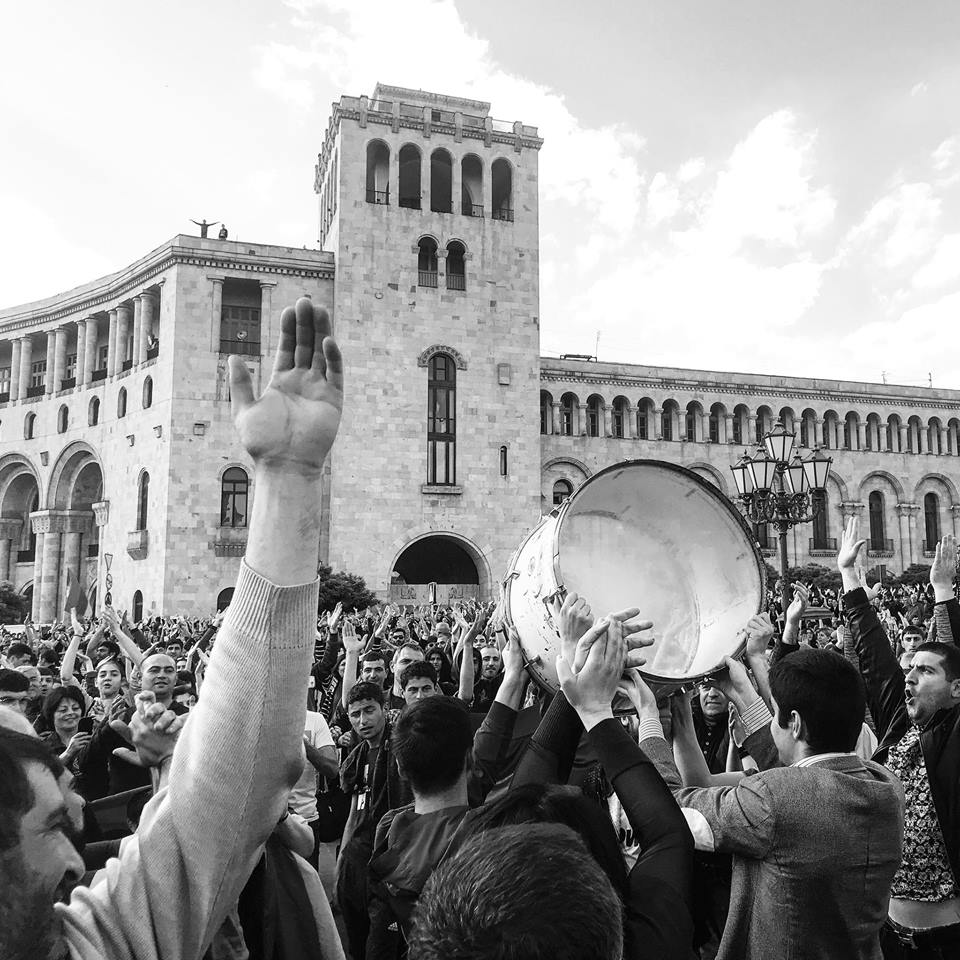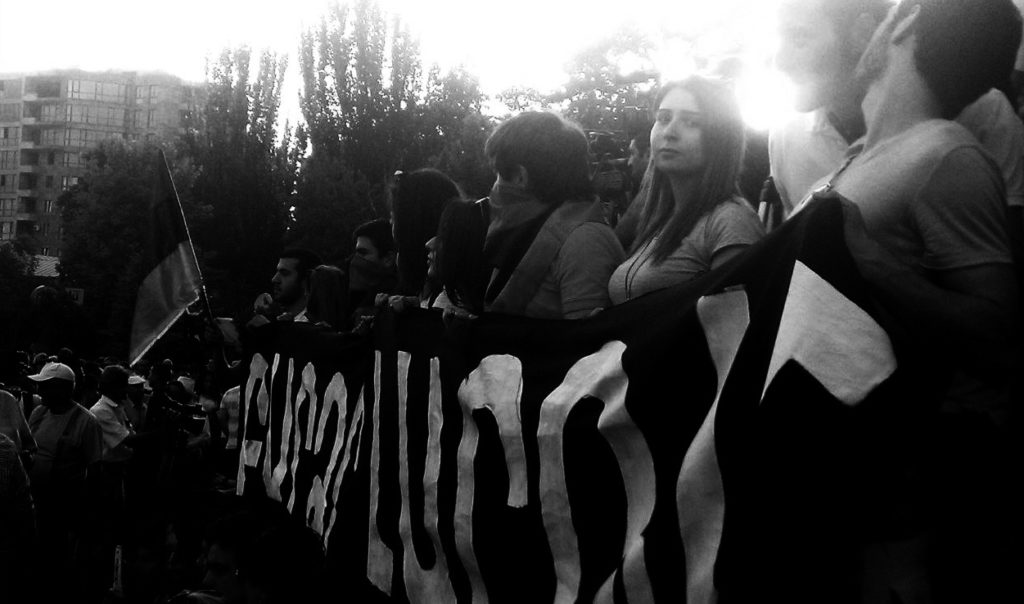
Special to the Armenian Weekly
In the middle of the Electric Yerevan protests in June 2015, I was walking around then-occupied Baghramyan Avenue, when I came across a young breaking student of mine named Hratch. I had seen him and his friends on the front-lines of the movement as far back as May, when the protests against electricity price hikes first began. He approached me and asked if he could do a brief interview for a newsletter they were putting together. After asking me general questions about the price hikes and my views regarding the occupation, his final question caught me a bit off guard:
“Do you think others in the world can learn anything from us?” he asked.
Here was a teenager on the streets of Yerevan, a few steps away from riot police, in a movement that had not even technically “succeeded” yet, asking me what the outside world might learn from them.
I almost didn’t know how to respond.
After thinking about it, I realized that for Hratch and many others around him, they were already victorious. Their aim was much bigger than merely the repeal of an increase in electricity costs. Their goal was to change the way people thought about and lived their lives. Their goal was to present a new model of change—one that was characterized by peaceful, non-partisan, non-aligned, collective, bottom-up, direct action.
In the context of the war that was happening in Ukraine at the time, and the many other violent episodes throughout Armenian and former Soviet history, what he was suggesting was that an active segment of the youth in Armenia—not just the 20- or 30-somethings, but the teenagers and even younger generation—were pointing a way toward a new model of progress. They themselves had drawn lessons from their own victories in Trchkan, Mashtots Park, 100 Dram, Dem Em, and other social movements. They felt they had something to offer those seeking social change not only in their own society, but around the world.
The current tidal wave of activism in Armenia, the surprising resignation of Serge Sarkisian, and the subsequent global attention the country is receiving, are only proving Hratch’s point. And today, that question rings in my ear louder than ever.
So, what are some lessons we can learn?
First of all, it is important to note that virtually all of the changes happening in Armenia, both now and in the recent past, have been led by young people at their core. Not just college students but even teenagers and young kids are coming out into the streets voluntarily, blocking thoroughfares, going on strike, and carrying out courageous acts of civil disobedience. They are not bogged down by the formalities and defeatism of the past but, rather, are forming a new consciousness in the country directly through coordinated action. This large youth presence alone sends a strong message to the authorities that the future will not be one of passive and apathetic citizens.
Second, these movements have all been defined by their non-violent nature. Not only do they utilize tactics of civil disobedience, they vocally disavow any use of force or coercion. This is no small task, especially in Armenia, where the norm since independence has been violent demonstrations and state brutality. This latest episode has shown, once again, that the state does not know how to react to such acts of non-violent resistance. Images on social media of overwhelmingly peaceful demonstrators being attacked by police—both uniformed and masked in plain clothes—only increased the resolve of the populace to struggle against the ruling regime.
Indeed, the main nail in the coffin for Sarkisian’s reign came on the day he publicly alluded to the face that there may be a repetition of the bloody events of March 1, 2008, when 10 people were killed and countless others injured in Yerevan.
Nikol Pashinyan, the figurehead of this latest movement, has consistently made it a point to renounce violence and has even summoned the teachings of Jesus Christ, urging his followers to “turn the other cheek” if they are confronted with violence. Indeed, the movement has been repeatedly described as one of “open hands” («բաց ձեռքերի»), emphasizing its disavowal of the use of force. Anyone who engages in any sort of violent act is immediately labeled a “saboteur” by those involved in the movement.
Third, all of these movements have been characterized by their horizontal nature. They do not have any true “leaders.” Their clarion call is “We are the owners of our country” («Մենք ենք տէրը մեր երկրի»), a slogan that emphasizes agency and active participation rather than reliance on a “savior” or outside power to bring salvation.
This was demonstrated in this recent case when authorities jailed Pashinyan, along with his fellow opposition parliamentarians Ararat Mirzoyan and Sasun Mikaelyan, in a futile effort to crush the movement. It failed to deter anyone. Instead, the response was an increase in the number of people who went to the streets with grassroots, independent strikes, picket lines, and street occupations.
Finally, the youth in Armenia have proven just how fickle power is. Like countless other examples throughout history, a seemingly impermeable regime once again collapsed within a few days when faced with popular resistance. The Republican Party (RPA), for all intents and purposes, is in shambles. Its sole reason for existence was to dominate the country and support the ruler in power. Despite some who will try to push it along and cling to their positions, its existence as an entity crumbled when Sarkisian was forced to resign.
All of these are lessons for those who hold illegitimate power throughout the world—and, more importantly, those struggling against them. And they are being brought to us not by NGO’s, not by Diasporans, not by foreign-funded initiatives, not by celebrities or “seasoned” bureaucrats but, rather, by a new generation of committed Armenian youth.
Of course, like many of his other fellow citizens, Hratch is on the streets this time around, as well. Most recently, he was blockading the entrance of SAS and Yerevan City supermarkets in the capital, calling on people to boycott stores ran by oligarchs such as Samuel Aleksanyan and Artak Sargsyan. He could be heard chanting: “The end of oligarchy is here” («Օլիգարխիայի վերջը եկել ա») and “No to exploitation—yes to justice” («Ո՛չ շահագործմանը… Այո՛ արդարութեանը»). This is certainly the next step in the movement to establish social justice and democracy in the country: The struggle against oligarchs, who have massively enriched themselves at the expense of the country’s people and resources.

As in 2015, the youth on the streets are already victorious. They are victorious in transforming the consciousness of the country and breaking the fear of the past and the coercive relations of the state to society. They are demonstrating that democracy is dictated not by what is put down on a piece of paper, but by what is integrated into the daily habits of a people.
For all of these reasons, we have a lot to learn from them… And a lot more to do in way of supporting their struggle.


The resignation of PM Sargsyan is not enough.
Even if Pashinyan becomes PM, that is not enough because he will be stymied by the RPA majority in the National Assembly, and the people who support the RPA: judges, oligarchs, police, army, civil servants, businesses, and all kinds of thieves and murderers. The PM will be a mere figurehead.
The RPA establishment is fighting back and pretending it cares about the people when it really cares about two things only: money and power.
This revolution is about to fail unless the opposition can muster the power to shut down the country and force a new, fair election of the National Assembly and PM.
Then the RPA establishment must be taken down – root and branch.
Their ill-gotten funds overseas must be seized and repatriated.
Shame on those who have colluded with these establishment thieves for decades. We shall remember.